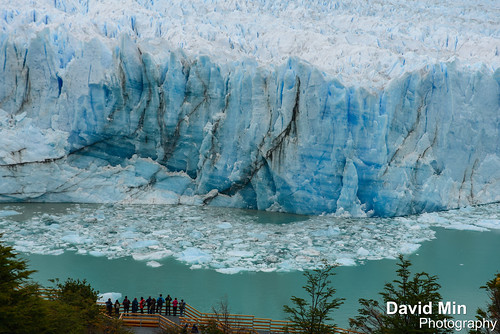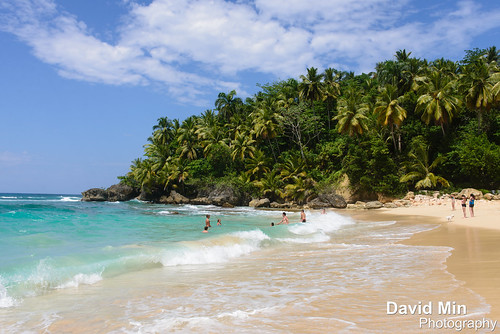The Perito Moreno Glacier is a glacier located in the Los Glaciares National Park in south west Santa Cruz province, Argentina. It is one of the most important tourist attractions in the Argentine Patagonia.
The 250 km2 ice formation, and 30 km in length, is one of 48 glaciers fed by the Southern Patagonian Ice Field located in the Andes system shared with Chile. This icefield is the world's third largest reserve of fresh water.
The Perito Moreno glacier, located 78 kilometres from El Calafate, was named after the explorer Francisco Moreno, a pioneer who studied the region in the 19th century and played a major role in defending the territory of Argentina in the conflict surrounding the international border dispute with Chile. The Perito Moreno Glacier is one of only three Patagonian glaciers that is growing. The reason remains debated by glaciologists.The terminus of the Perito Moreno Glacier is 5 kilometres wide, with an average height of 74 m above the surface of the water of Lake Argentino, in Argentina. It has a total ice depth of 170 metres. Pressures from the weight of the ice slowly pushes the glacier over the southern arm of "Lago Argentino" damming the section and separating it from the rest of the lake. With no outlet, the water-level on the "Brazo Rico" side of the lake can rise by as much as 30 meters above the level of the main body of Lake Argentina. Periodically, the pressure produced by the height of the dammed water breaks through the ice barrier causing a spectacular rupture, sending a massive outpouring of water from the Brazo Rico section to the main body of Lake Argentina. Due to its size and accessibility, Perito Moreno is one of the major tourist attractions in southern Patagonia. It is less than two hours by bus from El Calafate, and many tour companies run daily visits. A large visitor centre at the site features a walking circuit which allows visitors to view the southern flank and the east facing edge of the glacier.
In recent years, trekking tours on the ice have gained popularity. The two standard tours are a "mini-trekking" option, consisting of a short walk of about an hour and a half, and a "big ice" version, which is usually about five hours. Tour companies generally provide crampons to customers.
Tuesday, June 18, 2013
El Calafate, Argentina - Perito Moreno Glacier
Saturday, June 15, 2013
Cabrera, Dominican Republic - Playa Grande Beach
Cabrera is considered one of the most beautiful places in the Dominican Republic. Located facing the Atlantic, Cabrera has one of the most beautiful beaches, rivers, exotic vegetation and many natural attractions. A National Park reserve is located in El Breton, a small section of Cabrera called Cabo Frances Viejo. The most attractive beach in the area is Playa Grande (Big Beach), cited by Condé Nast Traveler as one of the most beautiful beaches in the world. Other local beaches include Playa Precioso, El Diamante (Diamond Beach), Playa La Entrada, El Caleton de Dario (Orchid Bay Beach), El Caleton del Medio, and El Caleton Chiquito.
Sunday, June 9, 2013
Ushuaia, Argentina - Les Eclaireurs Lighthouse
Les Eclaireurs Lighthouse (the French name "Les Éclaireurs" means "the Enlighteners") is a slightly conically shaped lighthouse standing on the northeastern-most islet of the five or more Les Eclaireurs islets, which it takes its name from, 5 Nautical mile east of Ushuaia in the Beagle Channel, Tierra del Fuego, southern Argentina.
The brick-built tower is 10 metres high and 3 metres wide at the base, with its windowless wall painted red-white-red and topped by a black lantern housing and gallery. Only a door pointing to the west provides access to the building. The light is 22.5 metres above sealevel emitting white flashes every ten seconds with a range of 7.5 nautical miles (13.9 km). The lighthouse, still in operation, is remote-controlled, automated, uninhabited, and not open to the public, guarding the sea entrance to Ushuaia. Electricity is supplied by solar-panels. On December 23, 1920 the lighthouse was put into service - today probably the most photographed lighthouse in South America.
It is a popular tourist attraction, reached on short boat tours from Ushuaia. It is known to the Argentines as the Lighthouse at the End of the World (Faro del fin del mundo), although that name is misleading. The lighthouse is often confused with the San Juan de Salvamento lighthouse on the east coast of the remote Isla de los Estados, made famous by Jules Verne in the novel The Lighthouse at the End of the World, which is actually much further east.
Sunday, June 2, 2013
Paris, France - Sout Africa Season Lights Up Eiffel Tower
THE EIFFEL Tower in Paris has had a Mzansi make-over – it has been lit up in the colours of our flag – to launch The South African Season in France. The tower will stay lit in the South African flag colours for a week, and will then be re-lit in the same way in the week leading up to Nelson Mandela’s birthday.
Alongside Nelson Mandela Day and the Nelson Mandela Exhibition, SA Season organisers will promote the 67 minutes of activism programme to encourage the French to spend time helping those less fortunate than themselves.



